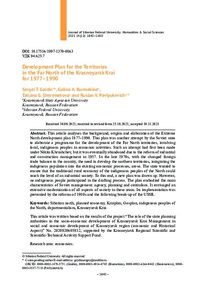Особенности развития территорий Крайнего Севера Красноярского края в 1977–1990 гг.
Скачать файл:
URI (для ссылок/цитирований):
https://elib.sfu-kras.ru/handle/2311/145032Автор:
Гайдин, С. Т.
Бурмакина, Г. А.
Шереметова, Т. Г.
Павлюкевич, Р. В.
Gaidin, Sergei T.
Burmakina, Galina A.
Sheremetova, Tatiana G.
Pavlyukevich, Ruslan V.
Дата:
2021-12Журнал:
Журнал Сибирского федерального университета. Гуманитарные науки. Journal of Siberian Federal University. Humanities & Social Sciences; 2021 14 (12)Аннотация:
В статье анализируются предпосылки и разработка плана развития
территорий, относившихся к Крайнему Северу Красноярского края на 1977–
1990 гг. Подобная попытка уже предпринималась в начальный период хрущевских
преобразований, но ее реализация была прекращена в 1957 г. после начала реформы
управления промышленностью и строительством в СССР. В связи с изменением
внешнеторгового баланса страны в конце 70-х гг. ХХ в. вновь возникла необходимость
развития северных территорий. Разработанный на уровне руководства страны
документ был построен на принципах планового развития единого хозяйственного
комплекса страны, определения роли конкретных территорий в общесоюзном
разделении труда, ответственности министерств и ведомств за его претворение
в жизнь. Но начало политики «перестройки» привело к фактическому отказу от его
практической реализации This article analyses the background, origins and elaboration of the Extreme North development plan 1977–1990. This plan was another attempt by the Soviet state to elaborate a programme for the development of the Far North territories, involving local, indigenous peoples in economic activities. Such an attempt had first been made under Nikita Khrushchev, but it was eventually abandoned due to the reform of industrial and construction management in 1957. In the late 1970s, with the changed foreign trade balance in the country, the need to develop the northern territories, integrating the indigenous population into the existing economic processes, arose. The state wanted to ensure that the traditional rural economy of the indigenous peoples of the North could reach the level of an industrial society. To this end, a new plan was drawn up. However, no indigenous people participated in the drafting process. The plan embodied the main characteristics of Soviet management: agency, planning and centralism. It envisaged an extensive modernization of all aspects of society in these areas. Its implementation was prevented by the reforms of 1980s and the following break-up of the USSR

